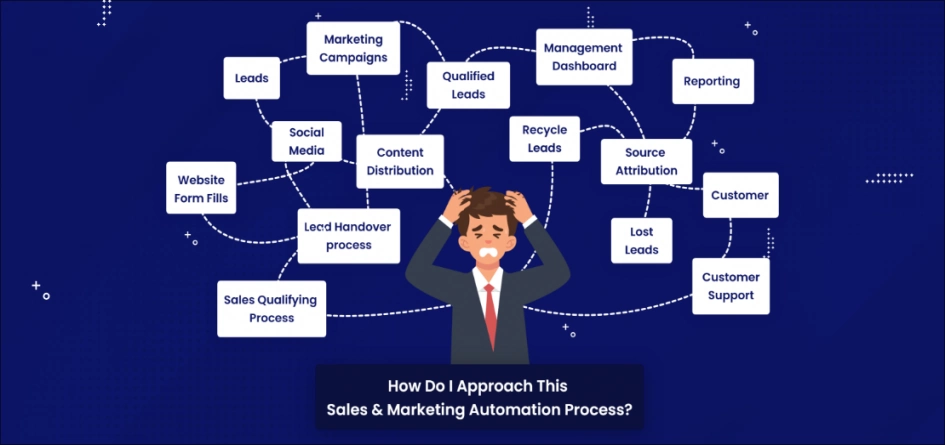

As Andrew Spany says “Automation does not redesign anything. In fact it does not even ask if we have to do certain things at all! Automation operates at the task level and not at the end-to-end process level”, the author of 4 process management books. In this blog, let's explore the importance of optimization before automation.
A recent McKinsey study shows that many organizations have struggled to meet automation project targets, with only 50% reporting project success. Another market report showed 55% of companies are not able to finish the complete automation process or fail to reap the planned benefits they had thought of before starting marketing automation implementation in their companies.
Of course there are various reasons for it, which can be tagged with multiple categories, be it budget overshoot, bandwidth issues, change in management, over estimated ROI, team adoption and many more. But, the most basic and fundamental reason which makes this whole activity a failure is that companies did not plan it well by optimising their business processes for good before automating those, they just implemented it “as-is”.
Have you heard the saying “if you are not planning, you are planning to fail”?. Before getting into automation, the first step is to decide what can be automated and what can not.
Optimizing the company’s process has two phases:
As mentioned earlier, automation works on the task level and not at the process level. Therefore, companies need to break the whole process into sub-processes and sub-processes into tasks. And then plan to automate those smaller tasks.
These steps are beneficial in optimizing your company’s processes. We have given a detailed note below on how to efficiently automate processes using the phases above.
Having complex processes always makes the job tedious and hence deconstructing the tasks is a better way to go ahead. Breaking down the tasks can be further divided into three categories:
Before implementing automation, the companies need to check the tasks that are repetitive and can be automated and those that are variable in nature and need human intervention.
Here’s what it means:
Marketing teams sending email campaigns to segmented contacts can be automated, but sales emails to the customer can't because that requires context, empathy and needs to be engaging.
Writing content can’t be automated but content distribution can be automated
The industry is moving towards the new AI technologies and trying to replace the human mind with the machine learning algorithm. But we still need some time to reach there, so that we can logically replace the human mind. All the physical or labour intensive work can be automated with RPA (robotic process automation) technology. Here’s how it works:
Reporting can be automated as it follows a collection of required data and converts that data into information with the help of formulas and representations of data. But, with the help of reports creating a strategy based on the available resources is difficult.
Marketing teams sending drip and nurturing emails to segmented contacts can be automated, but writing email copy can't because that requires context, empathy and needs to be engaging.
Most of the independent tasks where third-party interaction is not involved can easily be automated with the help of RPA. The moment a third-party interaction is involved, empathy and emotional Intelligence become the key success factors for that particular task, and the process automation becomes complex. Here’s how it works:
Before deploying the automation, companies should first focus on process improvement. Uplifting the processes to best in class can make everyone’s life easier and the final results will be overwhelming. Remember, “as-is” implementation of the automation process leads to failure.
For instance, optimizing the process can reduce the timeline and associated costs, making it more efficient. Most of the companies reaching out to automation have complex processes, which include unnecessary steps. The best way of optimizing the process is by eliminating the unnecessary approvals, not worthy data inputs, and reports which are adding no value in the decision-making process.
“We were working with a medium-size company (B2C industry) and were in a strategy consulting meeting to automate the lead assignment process for their 5 BU’s. They defined the process and shared the requirements document with us. While we were evaluating the requirements we noticed that every single lead generated through 5 BU’s marketing teams are routed through a common sales administrator and the sales administrator will pass on every lead through certain qualifying conditions and assign it to a BU sales executive afterwards, before sales could take any action on it. This whole process was taking 24 to 48 hours because of the manual intervention.”
We, then, discussed the same with the sales administrator and asked how he is qualifying a lead for any BU. While having a discussion, it was realized that it was all rules of thumb, which he was following. He said,-the process can be automated with the help of the system easily using a simpler approach. We tried automating and here we go, the leads were getting assigned almost in real-time. The images below give a know-how of how a company’s processes look before and after the automation.
However, optimizing the company’s whole process may take time and cost as it might require restructuring the team. But, this whole exercise of optimizing the company processes before automating will result in a better ROI as compared to automating the process without optimizing it.
Please share your thoughts in the comments and tell us how you are using marketing automation? Are you following the process of optimizing before automating? What method of automation do you find better and why?